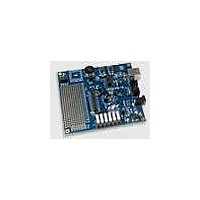C8051F015DK Silicon Laboratories Inc, C8051F015DK Datasheet - Page 134

C8051F015DK
Manufacturer Part Number
C8051F015DK
Description
MCU, MPU & DSP Development Tools Dev Kit for F015-19
Manufacturer
Silicon Laboratories Inc
Datasheet
1.C8051F005-TB.pdf
(171 pages)
Specifications of C8051F015DK
Processor To Be Evaluated
C8051F01x
Interface Type
USB
Lead Free Status / RoHS Status
Lead free / RoHS Compliant
- Current page: 134 of 171
- Download datasheet (2Mb)
18.1.3. Mode 2: 9-Bit UART, Fixed Baud Rate
Mode 2 provides asynchronous, full-duplex communication using a total of eleven bits per data byte: a start bit, 8
data bits (LSB first), a programmable ninth data bit, and a stop bit (see timing diagram in Figure 18.6). On transmit,
the ninth data bit is determined by the value in TB8 (SCON.3). It can be assigned the value of the parity flag P in
the PSW or used in multiprocessor communications. On receive, the ninth data bit goes into RB8 (SCON.2) and the
stop bit is ignored.
Data transmission begins when an instruction writes a data byte to the SBUF register. The TI Transmit Interrupt
Flag (SCON.1) is set at the end of the transmission (the beginning of the stop-bit time). Data reception can begin
any time after the REN Receive Enable bit (SCON.4) is set to logic 1. After the stop bit is received, the data byte
will be loaded into the SBUF receive register if the following conditions are met: RI must be logic 0, and if SM2 is
logic 1, the 9
If these conditions are met, the eight bits of data are stored in SBUF, the ninth bit is stored in RB8 and the RI flag is
set. If these conditions are not met, SBUF and RB8 will not be loaded and the RI flag will not be set. An interrupt
will occur if enabled when either TI or RI are set.
The baud rate in Mode 2 is a direct function of the system clock frequency as follows:
The SMOD bit (PCON.7) selects whether to divide SYSCLK by 32 or 64. In the formula, 2 is raised to the power
SMOD, resulting in a baud rate of either 1/32 or 1/64 of the system clock frequency. On reset, the SMOD bit is
logic 0, thus selecting the lower speed baud rate by default.
18.1.4. Mode 3: 9-Bit UART, Variable Baud Rate
Mode 3 is the same as Mode 2 in all respects except the baud rate is variable. The baud rate is determined in the
same manner as for Mode 1. Mode 3 operation transmits 11 bits: a start bit, 8 data bits (LSB first), a programmable
ninth data bit, and a stop bit. Timer 1 or Timer 2 overflows generate the baud rate just as with Mode 1. In
summary, Mode 3 transmits using the same protocol as Mode 2 but with Mode 1 baud rate generation.
SPACE
MARK
BIT TIMES
BIT SAMPLING
th
bit must be logic 1.
START
BIT
Figure 18.6. UART Modes 2 and 3 Timing Diagram
D0
D1
Mode 2 Baud Rate = 2
D2
Rev. 1.7
D3
SMOD
D4
* (SYSCLK / 64).
D5
C8051F000/1/2/5/6/7
C8051F010/1/2/5/6/7
D6
D7
D8
STOP
BIT
134
Related parts for C8051F015DK
Image
Part Number
Description
Manufacturer
Datasheet
Request
R
Part Number:
Description:
SMD/C°/SINGLE-ENDED OUTPUT SILICON OSCILLATOR
Manufacturer:
Silicon Laboratories Inc
Part Number:
Description:
Manufacturer:
Silicon Laboratories Inc
Datasheet:
Part Number:
Description:
N/A N/A/SI4010 AES KEYFOB DEMO WITH LCD RX
Manufacturer:
Silicon Laboratories Inc
Datasheet:
Part Number:
Description:
N/A N/A/SI4010 SIMPLIFIED KEY FOB DEMO WITH LED RX
Manufacturer:
Silicon Laboratories Inc
Datasheet:
Part Number:
Description:
N/A/-40 TO 85 OC/EZLINK MODULE; F930/4432 HIGH BAND (REV E/B1)
Manufacturer:
Silicon Laboratories Inc
Part Number:
Description:
EZLink Module; F930/4432 Low Band (rev e/B1)
Manufacturer:
Silicon Laboratories Inc
Part Number:
Description:
I°/4460 10 DBM RADIO TEST CARD 434 MHZ
Manufacturer:
Silicon Laboratories Inc
Part Number:
Description:
I°/4461 14 DBM RADIO TEST CARD 868 MHZ
Manufacturer:
Silicon Laboratories Inc
Part Number:
Description:
I°/4463 20 DBM RFSWITCH RADIO TEST CARD 460 MHZ
Manufacturer:
Silicon Laboratories Inc
Part Number:
Description:
I°/4463 20 DBM RADIO TEST CARD 868 MHZ
Manufacturer:
Silicon Laboratories Inc
Part Number:
Description:
I°/4463 27 DBM RADIO TEST CARD 868 MHZ
Manufacturer:
Silicon Laboratories Inc
Part Number:
Description:
I°/4463 SKYWORKS 30 DBM RADIO TEST CARD 915 MHZ
Manufacturer:
Silicon Laboratories Inc
Part Number:
Description:
N/A N/A/-40 TO 85 OC/4463 RFMD 30 DBM RADIO TEST CARD 915 MHZ
Manufacturer:
Silicon Laboratories Inc
Part Number:
Description:
I°/4463 20 DBM RADIO TEST CARD 169 MHZ
Manufacturer:
Silicon Laboratories Inc










